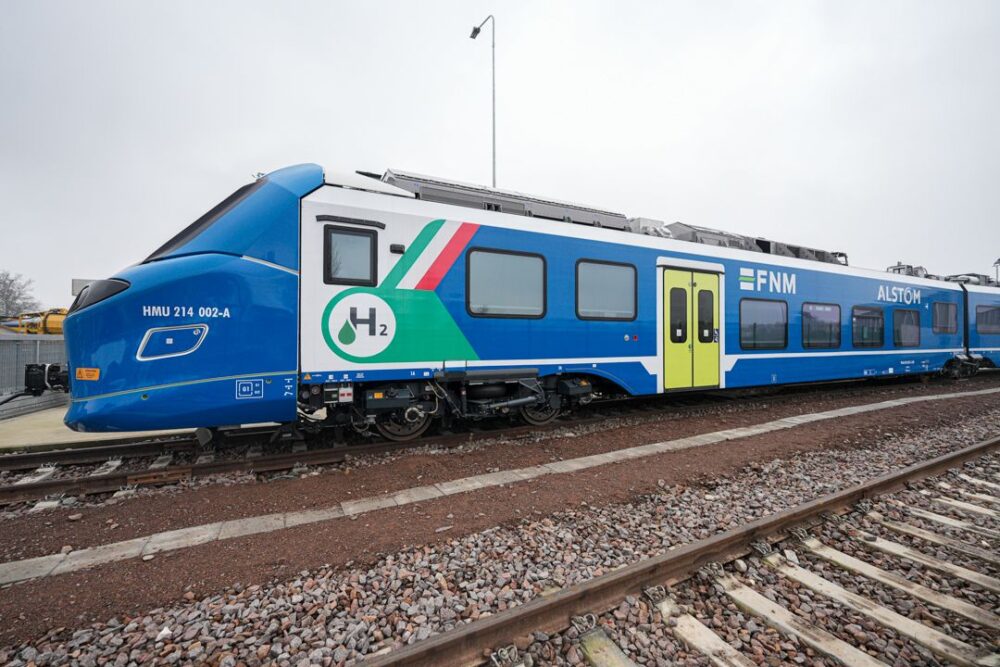The hydrogen train: the innovative project, at the start in Lombardy, reduces CO₂ emissions and introduces an infrastructure dedicated to refueling. A decisive step towards the decarbonisation of rail transport and a future with low environmental impact
“All on board”: the train in hydrogen is leaving
The new train, which will enter service on the Brescia-Iso-Edolo line, represents the first concrete application of hydrogen in the Italian railway sector. This is an innovative solution designed for non -electrified sections, where only diesel trains were used to date. The goal is to progressively eliminate the most polluting convoys, replacing them with zero emission technology, capable of guaranteeing the same operational efficiency but with a decidedly lower environmental impact.
The project is part of the initiative H2iseodeveloped by fnm, Ferrovienord e Trenordwhich provides for the creation of a complete infrastructure for the production and distribution of hydrogen. In addition to the fourteen trains that will be gradually introduced on duty, the plan provides for the construction of plants for the production of renewable hydrogen in Iseo, Edolo and Brescia, which will ampize the entire regional transport system.
This innovation brings with it a series of environmental and technological benefits. The reduction of carbon dioxide emissions and particulates will improve air quality in the areas crossed by the railway line, contributing to greater sustainability. In addition, the hydrogen train, unlike the diesel ones, will guarantee a more comfortable travel experience. In fact, it significantly reduces noise pollution. Its autonomy will be comparable to that of fossil fuels, without the need for electrification of the lines. Which represents a solution particularly suitable for regional sections and less infrastructured areas.
The Rovato plant: the first refueling center for hydrogen trains
At the same time as the introduction of the new convoy, the first Italian refueling and maintenance plant for these types of trains was built in Rovato, in the province of Brescia. A technologically advanced structure, designed to meet the specific needs of the new railway fleet and guarantee maximum operational efficiency.
The deposit includes five outdoor parking stations and a specialized workshop, with two covered tracks dedicated to the maintenance of trains. The refueling of hydrogen takes place through a high pressure system, capable of guaranteeing maximum safety and speed in the operations. The site is equipped with sophisticated monitoring systems, with sensors for detecting any gas leaks, fire -fighting systems and advanced ventilation mechanisms.
The total investment for the construction of this plant has exceeded 30 million euros, of which a party financed by PNRR. Its activation will gradually take place, in parallel with the testing stages of hydrogen trains and their progressive introduction on duty. But why is this novelty so important?
The role of hydrogen in the energy transition
Hydrogen is now considered one of the keys of the global energy transition. It is an extremely versatile energy carrier, capable of storing and transporting energy efficiently and, above all, without CO₂ emissions when produced with renewable sources. However, not all hydrogen is the same and its sustainability depends on the production mode.
Gray hydrogen, currently the most common form, is obtained from natural gas through the reforming of methane (a chemical process that extracts hydrogen from natural gas through high temperature reactions with water steam). This process, however, involves a high production of carbon dioxide. Which, making it not very sustainable from an environmental point of view.
On the other hand, blue hydrogen represents a more ecological alternative: it is produced with the same technique as gray hydrogen, but with a cod capture and storage system, which reduces emissions into the atmosphere.
Green hydrogen, on the other hand, is the most sustainable form and is the one that will be used to feed the new Lombard railway system. It is obtained through the water electrolysis process, using only energy from renewable sources. This means that green hydrogen production does not involve any greenhouse gas emission, making it one of the most promising solutions for the decarbonisation of the transport sector.
The H2iseo project involves the construction of three green hydrogen production plants in Brescia, Edolo and Iseo, which will be powered with renewable energy and will guarantee a completely sustainable energy supply chain.
A model for the future of mobility
The introduction of the first train to hydrogen and the development of the Hydrogen Valley lombarda They represent a concrete example of how it is possible to combine innovation and sustainability. This model may soon be replicated in other Italian regions and in various sectors of public transport, contributing to the reduction of the ecological imprint of the entire national mobility system.
Parallel to the railway sector, hydrogen is also gaining space in road and naval transport. The project SerraH2Valleprovides for the creation of a network of refueling stations for hydrogen vehicles, which will be installed along the main road arteries of northern Italy.
Hydrogen, therefore, is not only the future of transport railway, but a strategic resource intended to revolutionize the entire world energy panorama. The investment in this technology represents a winning bet not only for the environment, but also for economic and industrial development, opening the way to new opportunities for growth and innovation.
The road to a world a zero emissions It is still long, but with initiatives like this, Italy proves to be on the right route. The ecological transition is no longer a utopia, but a reality that is taking shape day after day, with concrete projects and sustainable solutions for a cleaner and safer future for everyone.




